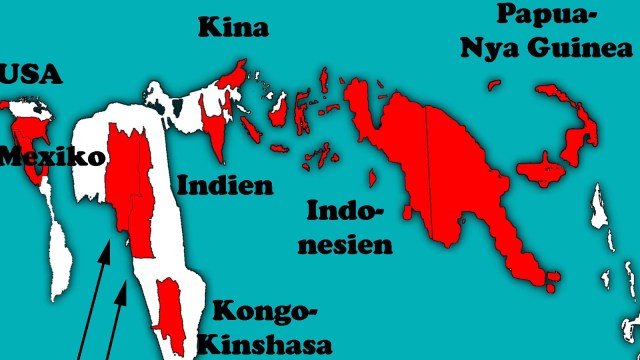Mapping Europe’s Linguistic Diversity via the Lord’s Prayer

This is the Europa Polyglotta, published in 1730 by Gottfried Hensel (or Henselius, after the contemporary fasion of latinising surnames). Its full title, translated from Latin: ‘Multilingual Europe, showing the genealogy of the languages, together with the alphabets and modes of writing of all peoples’.
The alphabets shown in the upper left corner, are (left to right): Scythian, “born of Hebrew”, Greek, Marcomannic, Runic, Moeso-Gothic, and Picto-Hibernic. In the upper right corner are shown Characteri Rutenicae Linguae, i.e. the Russian alphabet. The lower left corner shows the Latin, German and Anglo-Saxon alphabets. At the bottom, there are several other alphabets of the Hunnish, Slavonic (Cyrillic), Glagolitic (Illyric) and Etruscan (Eugubina) languages.
The map itself attempts to show the concordances and differences between all the ancient languages spoken in Europe by spelling out the first words of the Lord’s Prayer in each of them, in King-James English: “our father who art in heaven (hallowed be thy name)”.
Germanic languages:
- Thulae I[nsula] (Icelandic): Fader uor þu som ert a himnum helgest þitt nafn
- Gothica (Gothic): Atta unsar þu in himinam, weihnai namo þein
- Picto-Scotica (Scots): Vren fader ƿic arþ in heofnas
- Anglo-Saxon[ica] (English): Faeder ure þu þe eart on heofenum
- Germanica (German): Vater Unser der du bist im Himmel. Geheiliget werde dein Nahme
- Belgica (Dutch): Onse Uader, die in de Hemelen. Uwen Nam werde geheyligt
- Dania (Danish): Vor Fader i Himelen Helligt vorde dit Nafn
- Antiqu[a] Saxonica (Saxon): Thu ure Fader the eart on heofenum
- Norwegica (Norwegian): Wor Vader du som est y himmelen Gehailiget worde dit Nafn
- Svecica (Swedish): Fader war som ast i Himmelen. Helgat warde titt Nampn
- Runica (ancient Scandinavian, in the Runic alphabet): ᚠᛆᚦᚽᛦ ᚢᚭᛦ ᛋᚭᛘ ᛆᛋᛐ ᛁ ᚼᛁᛘᛚᚢᛘ ᛫ ᚼᛆᛚᚴᛆᚦ ᚠᛆᚱᚦᚽ ᚦᛁᛏ ᚿᛆᛘᛆ (Fader uor som est i himlum. Halgad warde thitt nama)
Romance languages:
- Gallica (French): Nostre Pere qui es es cieux. Ton Nom soit Sanctifié
- Foro-Juliani: Pari nestri ch’ees in Cyl. See sanctificaat la to Nom
- Hispanica (Spanish): Padre nuestro, que estas en los cielos. Sanctificado sea el tu Nombre
- Catalanica (Catalan): Pare nostro que estau en lo cel
- Lusitania (Portuguese) Padre nostro que stas nos ceos. Sanctificado seia oteu Nome
- Italica (Italian): Padre nostro, che sei ne’Cieli. Sia Sanctificato il tuo nome
- Hetrusca-Latina (Latin): Pater noster qui es in coelis
Slavic languages:
- Nova Zemblicae (Nova Zemblian?): Otcse nay icse zina nebey pozuetytze ime tuye
- Russica (Russian): Otse nashishe jeszi unebeszih. Posuetisze imè toye
- Polonica (Polish): Oicze náss, ktorys jest w niebiesiech. Swiecsie imic twoie
Other languages:
- Hibern[ica] (Irish): ar nat[hair] ata ar neam[h]
- Lithuanica (Lithuanian): Tewe musu kursey esi danguy. Szweskis wardas Tawo
- Lapponica (Saami): Isa meidhen joko oledh tajuahisza Puhetta olkohon siun Nimesi
- Finnonica (Finnish): Isa meiden joca olet taiwaisa. Pyhittetty stolcon sinum Nymes
- Biscaina sive Cantabrica (Basque): Gure aita cerue tan aicena. Sanctifica bedi sure Icena
- Graeca (Greek): Πάτερ ἡμῶν ὁ ἐν τοῖς οὐρανοῖς· ἁγιασθήτω τὸ ὄνομά σου (pater hemon ho en tois ouranois, agiasteto to onoma sou)
- Hungarica (Hungarian): Mi Atyanc kivagy az mennyekben
- Tartarica (Tatar): Yâ Atamûz kiyûksèk Ghiôghda Sen

Strange Maps #231
Got a strange map? Let me know atstrangemaps@gmail.com.
Map found here on Wikimedia Commons.





